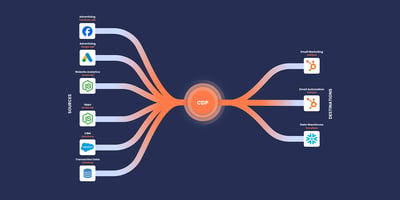Getting buy-in from the sales team on your shiny new CRM system can be tough, but it’s a critical step to enable your new CRM to impact your organisation in the right way,
In this blog, I’ll share my personal lessons learnt from implementing CRM systems at all manner of organisations over the last few years.
I'll present these lessons in six stages we go through with all CRM implementations. Considering these stages should help you manage the change and drive user adoption in your sales team. I’ll also outline where you will most likely come up against resistance.
I'll steer clear of IT and systems jargon and keep this post practical so anyone at any organisation who wants to implement change and focus on customers and growth can get it done.
Whether your function is sales, operations, IT, leadership, or even admin - you can drive a CRM project. Just involve the right people along the way.
The stages of a CRM project
- Problem identification
- Vendor/solution selection
- Onboarding and setup
- CRM pilot group
- CRM Launch
- CRM Enhancements
Now to manage the change well and promote user adoption, you need to involve the sales team at each stage.
Now when I mention the sales team - I generally mean sales leaders or key salespeople. Involving the entire sales team in most operations is not practical. These key salespeople can share with the greater sales team as necessary.
1. Problem Identification
This is the genesis of a CRM project. A problem with sales can be identified quickly with a sudden realisation that things are broken. Or it can be slow and painful process to realise change is necessary. A missed target, a competitor eating into market share, difficulty holding onto sales talent, or even frustrations from the ops team that the sales team doesn’t follow process.
Regardless, you come to the conclusion that your current sales process, methodologies, and systems are not up to scratch. A new CRM and updated process is the answer.
At this point, ask sales leaders what they think the problems are. Survey the teams as well. This is the beginning of the buy-in process. Even if some users come back with fluffy answers, they were consulted, and you can manage the narrative.
2. Vendor Identification
The next step is to identify potential CRM vendors. It’s key to have sales leaders as part of this process. They will bring experience with previous CRMs to the table, as well as recommendations.
Do not make this solely the IT department's responsibility. IT typically focuses on lists of functionality and interoperability. Of course, these are key, but they are only part of the picture when it comes to user adoption and change management. Sales must be present in some form. Additionally, IT tends to market with the same vendors they already use. Again, not a bad thing, but ideally, the net needs to be cast wider.
Yesterday I sat with a large listed company of 5000+ employees - we were the first in a long process of initial meetings with CRM vendors. They had identified five. It was a 1.5 hour meeting, and based on their complex requirements, we needed another meeting. The process takes time. I wish I could tell them that they only need to consider three of the five vendors selected - two are not fit for purpose - but it’s their process, and they need to go through it to learn.
In most cases, the CRM vendor (eg. HubSpot CRM or Salesforce) will demo the solution with a certified implementing partner. In our case, HubSpot uses us to do all of their larger or complex CRM work in Africa and the Middle East.
In this particular meeting, the following people were present:
- Head of Strategic Sales and Marketing
- Head of Applications
- Digital & IT Executive
- Chief Operating Officer
The Head of Strategic Sales and Marketing represented the sales team, and she in fact ran the meeting from the client side. A great start, I thought.
3. Onboarding and Setup
The business has made CRM vendor decision (of course, you selected HubSpot 😉), and you are busy with the discovery and sales process configuration. This may include multiple pipelines, stages within those pipelines, automation, custom properties, and checklists to make sure the sales teams work to a unified process.
Sales leaders must be present during this phase. If you leave this process to operations and IT, it is bound to cause frustration for sales folk. Operationalising the sales process from your business's point of view is great, but salespeople work with clients and try their best to fit your products and processes to them.
If you build your sales process with sales leaders, you are far more likely to find the right balance between your company's operational requirements and your clients' needs.
Sales leaders can also share feedback and progress of the project with their sales teams. I know this might seem insignificant, but this drives ownership through the sales team - even if they are not entirely involved. This feedback is key to a successful launch and buy-in.
Remember that salespeople will still need to hit their targets and KPIs despite the extra work and sales process interruption they will experience with a change. This hurdle has to be climbed regardless of the efficiencies they will receive on the other side.
4. CRM Pilot Group
Your next step is to select a team to pilot the new CRM and its updated sales processes. Choose a small team, or a handful of salespeople who will likely give valuable feedback to you and their colleagues.
Migrate ALL contact and sales data before the pilot starts. The pilot team will maintain their deals and contacts in CRM. A final delta migration will be done before the full CRM launch.
Move them away from their old CRM or Excel spreadsheets; integrate email and calendar accounts in Outlook or Gmail; and make sure all emails, calls, and messages are being tracked. Ensure automation is working well, and there is some benefit to them being in the pilot group. Eg. They are allocated leads from the website first, or they get to interface with some important people in the company. There must be an immediate benefit - and thanks after the successful pilot.
5. CRM Launch
The CRM pilot was successful; kinks have been ironed out, and the pilot team is happy. They see the benefits of the new CRM system and realise it can be a productivity enhancer. They’ve shared the sentiments at water cooler chats with other sales team members. Time to roll out to the rest of the team.
Get the delta migration done. This migration updates all records with the contacts, deals, and activities since the initial pilot migration.
As soon as this is done, the sales teams must begin tracking all activity into the CRM. If there was a previous CRM, turn off access. Very importantly, if you are migrating from one system to another, keep that system active for a month or two after the cutover to the new system, in case some data has been missed. Keep your licensing running for that period.
Check daily that users are logging activity. This is a prime place for salespeople to fall back on spreadsheets and email communications to manage sales. Make sure activity is high, and offer support when it is not. Offer one-on-one training from your internal trainer or trainers from the implementation partner to bring laggards up to speed without them feeling less than. We also recommend group sessions early on where questions can be raised.
Sales leaders must run sales meetings from the CRM. They must keep track of targets and activities only on the CRM. Never again must a sales meeting be run on an Excel sheet.
One of the best methods to force adoption is the following:
If it’s not in the CRM, it doesn’t exist and didn’t happen. This applies to deals and customer communications. I don’t know how often I have heard, ‘I did call them; I just didn’t track it’. It can never happen again.
Be firm with usage. No commission will be paid if the deal is not in the CRM. Or it will be delayed. You know your company. But this is what I recommend.
6. CRM Enhancements
Your company is constantly evolving, and so are your prospects and customers. Your sales process and, in turn, your CRM needs to do the same. The hypotheses that you had during the onboarding and setup phase will need to be fine-tuned, and in some cases, entirely overwritten.
We do a review of our sales process at least once a year at our organisation, and we encourage our customers to constantly challenge the status quo of their process. New staff and environmental changes will naturally challenge your sales process. The important thing to manage is when to make a change and when to recognise it’s not necessary.
Conduct reviews with the sales team. Interacting regularly with them on the system is your best chance to gather real world data on the CRM's performance and potential enhancements.
On that, I can not advise. It’s on a case-by-case basis, and you know your business best. If you are unsure, contact the team that implemented your CRM system. They might be able to help you stress test your ideas before you go change things unnecessarily.
Final thoughts
Involve the sales team at each of these stages in your process. If you have a CRM in place already, focus on the enhancements section above. Involve sales leaders and make sure they communicate the coming change through their teams. Let them discuss it in their sales meetings and offer feedback and solutions.
Sales involvement throughout the process is key to successful change management and high rates of CRM user adoption in your sales teams.





